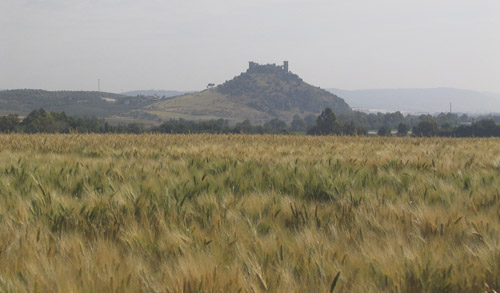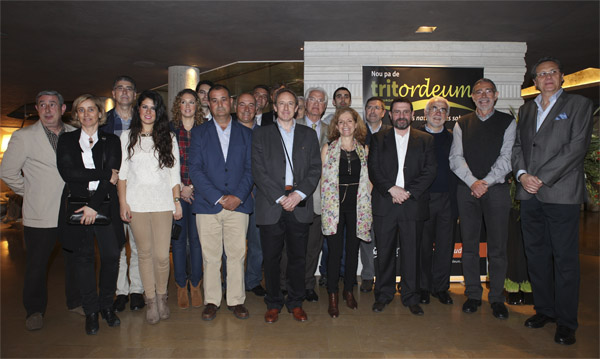The new cereal will be launched by the spin-off Agrasys and it is the first newly created cereal to be commercialized in the world for human consumption.
- Tritordeum has accreditation as natural crop species, and has been developed with traditional breeding techniques at the Institute of Sustainable Agriculture (IAS) of the Spanish National Research Council (CSIC) in collaboration with Agrasys- a spin-off of the CSIC, located at the Barcelona Science Park, which is now entering the market.
- This is the first newly created cereal marketed in the world for human consumption and is the result of the natural combination between durum wheat and a wild barley species native to Chile and Argentina, and is registered in the Community Plant Variety Office (CPVO) of the European Union.
- In addition to its pleasant taste, texture, aroma and color, Tritordeum has high levels of protein and fiber, 10-fold higher levels of lutein (an antioxidant involved in eye health) and less reactive gluten than common wheat, besides being rich in prebiotic compounds and essential minerals.
- Various gourmet bakery chains in Barcelona have already developed a wide range of breads and pastries with this new cereal.
 Barcelona. Agrasys, a spin-off of the Spanish National Research Council (CSIC) located at the Barcelona Science Park, has launched to the market Tritordeum, the first newly created cereal marketed in the world for human consumption. The official presentation took place at Hotel Claris in Barcelona, with a welcome by members of Agrasys and the participation of master baker Josep A. Ribas, author of the Cruixent artisan breads bakery, and Chef Josep M. Freixa, presently head of the Tradició Freixa Restaurant (awarded with a Michelin star).
Barcelona. Agrasys, a spin-off of the Spanish National Research Council (CSIC) located at the Barcelona Science Park, has launched to the market Tritordeum, the first newly created cereal marketed in the world for human consumption. The official presentation took place at Hotel Claris in Barcelona, with a welcome by members of Agrasys and the participation of master baker Josep A. Ribas, author of the Cruixent artisan breads bakery, and Chef Josep M. Freixa, presently head of the Tradició Freixa Restaurant (awarded with a Michelin star).
Tritordeum was first developed by Antonio Martín, research professor at the Institute of Sustainable Agriculture (IAS) of the Higher Council for Scientific Research (CSIC) and his research team, as part of a breeding program, started in 1977, which has resulted in a new crop cereal with beneficial health properties.
In 2006, Agrasys, a spin-off of the CSIC, created by a group of scientists from the academia and industry, acquired exclusive commercial rights to Tritordeum and its breeding program. Agrasys has now two registered varieties of Tritordeum and is working on the selection of new lines with characteristics in high demand by the industry and adapted to different environments, in collaboration with Dr. Martin and his IAS team in Córdoba.
Currently, several chains of gourmet bread bakeries in Barcelona such as Forns Enrich, Fleca Balmes, Cruixent and Forns Mistral, among others, who share the vision of producing high quality products, have developed breads and pastry products from this new cereal.
In parallel to its launch in Barcelona, Agrasys has closed or is negotiating several agreements to grant commercial licenses for Tritordeum in other European countries. Pilar Barceló, Agrasys general manager, explains: "In Spain, our model is to work directly with both grain producers and the manufacturers of products from cereals and ingredients. At the international level, including the European Union, we prefer to sell the rights to one or more companies so that these companies carry out commercialization, since they are the ones who know in depth their markets and consumers. "
The founding principles of the company Agrasys include a commitment to R & D + I excellence, the production of new knowledge, technologies and materials, and the exploitation of these results to produce new crop varieties in order to contribute to the sustainability and efficiency of agriculture and to produce food with real benefits for society.
 "Our business model is based on strategies based on continuous and productive partnerships with other companies and public and private research groups at all levels, from basic research to product sales. We strongly believe in the strength of our resources, but we also know that our growth and success depend on interactions with other public and private partners worldwide, "said Paul Lazzeri, research director at Agrasys.
"Our business model is based on strategies based on continuous and productive partnerships with other companies and public and private research groups at all levels, from basic research to product sales. We strongly believe in the strength of our resources, but we also know that our growth and success depend on interactions with other public and private partners worldwide, "said Paul Lazzeri, research director at Agrasys.
More than 30 years of development
Tritordeum is a cross between durum wheat and a wild barley species, Hordeum chilense, native to Chile and Argentina. This is the second cereal developed by man-the first one was Triticale, a combination of durum wheat and rye, which is used for animal feed. It is registered in the Community Plant Variety Office (CPVO) of the European Union and is a natural crop species.
CSIC researcher Antonio Martin explains that "the techniques used to develop Tritordeum are classic traditional breeding techniques based on crossbreeding and selection in the field of the best combinations and do not involve genetic modification". In addition, the expert adds, "it is a natural fertile cross that presents very interesting agronomic characteristics towards global warming."
Tritordeum, after more than 30 years of breeding, is a cereal with yields similar to those of the different varieties of wheat, and high resistance to drought and heat stress. It is a robust crop with good resistance to pathogens that needs little water and few fertilizers, characteristics that make it suitable for use in sustainable production systems with low environmental impact.
It is currently being cropped in Spain (Andalusia, Castile and Catalonia), southern Italy and southern Portugal, through systems of conventional and ecological production, and offers an alternative value added in both systems.
Nutritional and organoleptic properties
Tritordeum has specific qualities and functionalities not found in other cereals and that make it very suitable for producing innovative products in response to consumer demand and current market trends.
It has high levels of protein, fiber and lutein, an antioxidant involved in eye health (protects the retina from UV light and the effects of aging); has 10 times more levels of lutein than common wheat, and a higher proportion of dietary fiber, and it is rich in essential minerals and fructans, carbohydrates with a prebiotic action that help maintain intestinal bacterial flora. Furthermore, its levels of reactive gluten are lower than those of common wheat or spelt wheat and similar to those found in kamut, and is therefore, more easily digested by people with "non-celiac intolerance to gluten" (although, as with all grains, it is not suitable for celiacs).
Tritordeum is also characterized, in addition, by very good organoleptic characteristics, with its products having a pleasant taste and aroma and an attractive golden color brought about by its high lutein content.
About Agrasys, S.L.
Agrasys (http://www.agrasys.es) is a spin-off of the Higher Council for Scientific Research (CSIC) located at the Barcelona Science Park that was founded in 2005 by a group of academic scientists from the Institute of Sustainable Agriculture (IAS-CSIC) and the industry. It focuses its activity on the development of new varieties of crops with high value added and its projects are aimed at natural functional foods, innovative products and biomass and forage crops to generate benefits for society
Agrasys maintains a General Agreement of R & D and technological development licenses and exploitation with the CSIC, and maintains several collaborations with public research groups and European companies. It has received support from the Foundation Bosch i Gimpera of the University of Barcelona, from the Ministry of Science and Innovation, from the Center for Industrial Technological Development (CDTI), from ACC1Ó, and from the European Social Fund, among others. In 2008, the company also received an investment from the venture capital fund of Uninvest SGECR SA.
About the Institute of Sustainable Agriculture of Cordoba (IAS)
The Institute of Sustainable Agriculture (IAS) (http://www.ias.csic.es)was founded in 1992 as a unique center of the Spanish National Research Council (CSIC) in agricultural research, with a specific focus towards rain-fed and irrigated cropping and olive trees crops in order to harmonize food production with conservation of natural resources. Currently, IAS objectives focus on strategic analysis of resources to improve the sustainability of agriculture through research in agronomy, plant genetic breeding and crop protection. One of the most important products that has emerged from this institute is the cereal Tritordeum
